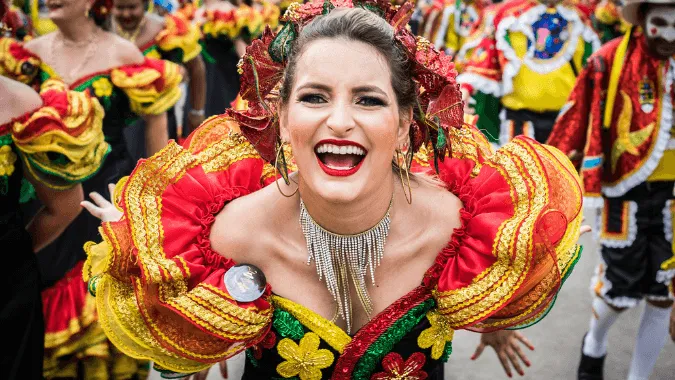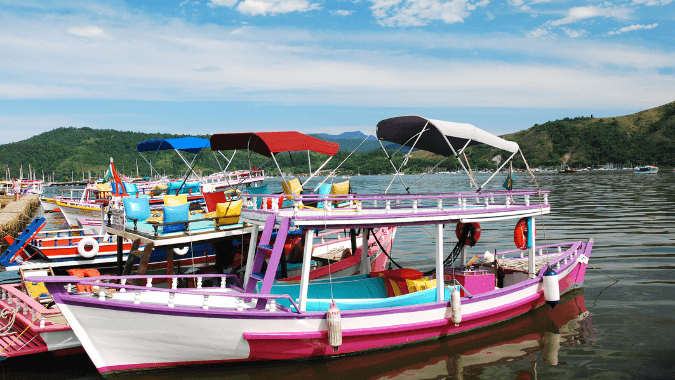A Celebration of Culture from Northeast Brazil
It’s 1 a.m. on Saturday morning in Rio de Janeiro and the sweaty, excited crowd is in full swing. However, there’s no throbbing dance music or DJ that has them moving; over 400 couples are swaying and whirling to traditional Brazilian folk music.
https://www.youtube.com/watch?v=bdd822f_Y14The Feira de São Cristóvão (officially called Centro Luiz Gonzaga de Tradições Nordestinas) is a celebration of food, dance, music and culture from the Northeast of Brazil. However, it’s more than just eating and partying. Shop for traditional musical instruments, take home artesanal craft or even purchase Northeastern art such as block prints - easy to stuff in your suitcase. The fair is popular with locals and due to its location in Rio’s inner-north, is considered by most tourists to be off the beaten track. It is frequently ranked as among as one of the best things to do in the city by Rio de Janeiro guides.
![Feira de São Cristóvão]() Feira de São Cristóvão is a celebration of all things Northeastern Brazil / Brazogo
Feira de São Cristóvão is a celebration of all things Northeastern Brazil / Brazogo
HISTORY
Feira de São Cristóvão is rooted in working class tradition, and to this day retains a very down-to-earth atmosphere. The origins of the fair can be traced back to the end of the Second World War, when labourers from the impoverished Northeast of Brazil arrived in Rio in 1945 to search for work. They were known as Nordestinos (Northeasterners) and established a strong community in the suburb of São Cristóvão, to the north of the city centre. The fair grew organically. The Nordestinos established trade routes with the northern states and established a market to sell produce and goods from their home region. On the weekends, their parties and celebrations attracted the interest of Rio locals and other Brazilians alike, and the fair grew in popularity over the decades. It was officially relocated to more formal grounds in 2003, and it now houses over 700 bars and stalls.CULTURE
Northeastern Brazilian culture is tough. The unforgiving year round heat of the northern states breeds strength, and Nordestinos are renowned for being resilient, resourceful and extremely hard working. Central to Nordestino identity is the archetype of the Pioneer. A salt-of-the-earth cowboy type who lives off the land, rides a stallion and remains stoic in the face of adversity and rejects authority. Traditional Nordestino dress is a suede leather jacket and buccaneer hat, often coupled with a cutlass or carbine rifle. There is plenty of original clothing and accessories on sale at the fair, including more peculiar items such as daggers and whips.![Feira de São Cristóvão]() You can learn all about the history and culture of Northeastern Brazil with a pocket-sized cordel / Brazogo
You can learn all about the history and culture of Northeastern Brazil with a pocket-sized cordel / Brazogo
FOOD
If there's one rule you must follow, it's this; don’t leave Feira de São Cristóvão hungry! Diners looking for authentic Nordestino cuisine will not be disappointed - although vegetarians might be. There are more than 35 restaurants, and with hundreds of other stalls offering snacks and food to take home, there’s enough to keep you satisfied. Try legendary Brazilian barbecue at Flor do Nordeste. Watch the grillmaster carefully cook in front of you, and choose the finest cuts of sun-cured beef direct from the flames. Or try sharing a bar snack such as escondidinho, a type of northeastern casserole, made from cassava, prawns and cheese sauce. It’s honest, no-nonsense food, served with a down to earth attitude. Barraca da Chiquita, featured in many guides to Rio de Janeiro, is famous for their feijoada nordestina. A traditional stew of white snake beans, sundried beef, trotters and cured linguiça, served with sides of okra, bur cucumbers, slabs of grilled halloumi and of course farofa (a kind of “sand” made from ground cassava flour and herbs). If you’ve managed to leave room for dessert, try something sweet like a tapioca. Tapioca is a kind of Brazilian pancake, made from (you guessed it), cassava. If you’ve noticed a common thread running through Nordestino cuisine, it’s because tapioca is a staple food in a regular northeastern diet. Planeta Tapioca serves up a mouthwatering range of choices including ground peanut and condensed milk, coconut and butter, and sweet guava jam with cheese.![Feira de São Cristóvão]() Diners looking for authentic Nordestino cuisine will not be disappointed / Brazogo
Diners looking for authentic Nordestino cuisine will not be disappointed / Brazogo
SHOPPING
Stock up on authentic Nordestino apparel such as a Cangaceiro, a crescent shaped cowboy hat traditionally worn by ranchers and bandits alike. Or pick up a few copies of some different cordels from the stalls in the central square. A cordel is a pocket sized poetry booklet with a woodblock printed cover featuring verses of rhyming couplets; a very Brazilian object and a great gift. If you want to take the flavours of the northeast home with you in a bottle, pick up a few bottles of cachaça. It’s the most famous Brazilian drink, and essentially a version of Brazilian rum made from sugarcane. Here’s a tip for choosing the best bottle; generally the older the cachaça, the better. ‘Young’ cachaça has a strong rum taste to it and is tea coloured, while older cachaça becomes clear over time and loses the cloying sweetness of its younger cousin. For a wide selection, check out the selection at Cachaça da Feira, selling the best Brazilian brands of cachaça from the northeast.FORRO
One of the major draw cards for the Feira de São Cristóvão is the live music on the weekends. Brazilians come from all over the city to dance to Forro (said; fo-ho), a type of one-step-two-step waltz danced to accordions and commonly accompanied by at least one person furiously dinging away at a steel triangle. There are two main Forro stages, with various other musicians sitting in smaller places among the fair. One of the best things to do in Rio de Janeiro is to explore its rich and vibrant culture through the eclectic range of music on offer. Forro is an easy dance to learn, and Brazilians aren’t shy either, so if you’re looking for a teacher you’ll more than likely find a willing instructor near the stage happy to show you the basics.![Feira de São Cristóvão]() Brazilians come from all over the city to dance to Forro / Brazogo
Brazilians come from all over the city to dance to Forro / Brazogo
GETTING THERE
Take a taxi, or jump in an Uber. There are ways to reach via public transport, but it’s not recommended and could be very difficult if you don’t know how to speak Portuguese. Do not walk to or from the fair. It is not safe to reach there on foot.WHEN TO VISIT
The best time to visit the fair is on weekends. It’s when things are most animated and you can enjoy the free live music. The fair opens at 10:00 a.m. on Friday morning and stays open until 8:00 p.m. on Sunday. Entry costs no more than R$5.00 per person, with children and senior discounts.By: Christopher Suttenfield: CEO of Brazogo, a Rio de Janeiro startup providing custom Rio travel guides. His love of Nordestino food is almost as grand as his inability to dance Forro.
-
Exciting 4x4 route: São Luís and FortalezafromUS$1,014
-
Vila Gale Mares Resort All InclusivefromUS$100
-
Ecotourism in Chapada DiamantinafromUS$672
-
All inclusive Vila Gelé Cumbuco ResortfromUS$999
-
Full Day Cafayate Tour from SaltafromUS$68
-
Transfer Aeroparque - Buenos AiresfromUS$46
-
-
Transfer Ezeiza - AeroparquefromUS$91
-
-
Excursion to El Chaltén from El CalafatefromUS$153
-
-
-
-
-
-
-
-
-
-
-







